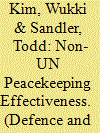| Srl | Item |
| 1 |
ID:
190152


|
|
|
|
|
| Summary/Abstract |
This research note extends the Bara and Hultman (2020) study on the effectiveness of non-UN peacekeeping missions in terms of curbing one-sided violence (OSV) against civilians. In particular, we employ two novel instruments to address the two-way causality between the number of non-UN peacekeepers and OSV measures. For each panel year, our instruments involve the interaction between the sum of various designated peacekeepers contributed and the inverse distance between the capitals of contributor and conflict countries. As required, the instrument satisfies the necessary inclusion and exclusion (exogeneity) requirements. The instrument-based results establish a robust reduction in government OSV stemming from the number of non-UN peacekeepers deployed. That reduction also holds for propensity-score matching and the inclusion of UN peacekeepers in the same regression. Non-UN peacekeepers did not have a robust influence on rebel OSV.
|
|
|
|
|
|
|
|
|
|
|
|
|
|
|
|
| 2 |
ID:
185489


|
|
|
|
|
| Summary/Abstract |
This paper examines the effectiveness of non-UN-led peacekeeping operations (PKOs) from two alternative perspectives. First, the four kinds of regional and international (out of region) PKOs are investigated based on their ability to curtail one-sided violence (OSV) against civilians by host governments or rebels. That analysis is further bolstered by propensity-score matching to ameliorate potential selection bias stemming from non-UN PKOs. For the matched sample, we find that non-UN peacebuilding and peace enforcement missions limit rebel caused OSV, which is a novel result. Second, the ability of non-UN PKOs’ troops and police to end conflict or to maintain peace are ascertained based on survival analysis. Non-UN troops, but not police, curtail the transition from peace, regardless of matching. Generally, non-UN PKOs display effectiveness in limiting OSV or maintaining peace, but not in ending conflict.
|
|
|
|
|
|
|
|
|
|
|
|
|
|
|
|